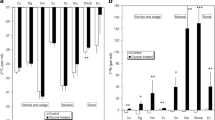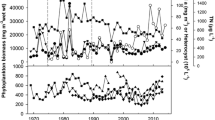Abstract
The role of nitrogen (N2) fixation in balancing N supply to wetland metaphyton was assessed by comparing primary production with enzymatic, isotopic, and elemental correlates. Primary production, N2 fixation (acetylene reduction, AR), phosphatase activity, C:N:P ratio, and N isotopic composition of metaphyton were measured along a nutrient gradient in a freshwater marsh during May through September 2004. N2 fixation and phosphatase activity in metaphyton were negatively correlated with inorganic N and P concentrations, respectively. Although metaphyton N2 fixation demonstrated a clear spatial pattern along the nutrient gradient, N2 fixation rates varied monthly and decreased sharply in September. However, the percent contribution of N2 fixation to N uptake by metaphyton consistently decreased throughout the summer. Furthermore, the decreased contribution of N2 fixation to N uptake corresponded with an increase in metaphyton N content during the growing season. Nitrogen isotopic data suggested the sustained importance of an atmospheric N2 source through September at the most downstream (nutrient poor) site even though the percent contribution of N2 fixition to N uptake was lowest in that month. This suggests that metaphyton were efficiently accumulating and recycling fixed N2 in support of primary production. Over the course of the summer, metaphyton primary production showed a weak inverse correlation with metaphyton phosphatase activity (r 2 = 0.58). The largest residuals in this regression corresponded to the largest vartiation in metaphyton N content. When metaphyton primary production was normalized to metaphyton N content, production rates for the entire growing season were more strongly inversely correlated with metaphyton phosphatase activity (r 2 = 0.78). Results of the study suggest that N2 fixation in N poor areas may adequately supplement community N requirements in metaphyton, thereby causing limitation by other elemental resources such as P.





Similar content being viewed by others
References
Borchardt MA (1996) Nutrients. In: Stevenson RJ, Bothwell ML, Lowe RL (eds) Algal ecology—freshwater benthic ecosystems. Academic Press, San Diego, CA
Clesceri LS, Greenberg AE, Eaton AD (1998) Standard methods for the analysis of water and wastewater, 20th edn. American Public Health Association, Washington DC
Doyle RD, Fisher TR (1994) Nitrogen fixation by periphyton and plankton on the Amazon floodplain at Lake Calado. Biogeochemistry 26:41–66
Dworkin SI (2003) The hydrogeochemistry of the Lake Waco drainage basin, Texas. Environ Geol 45:106–114
Fairchild GW, Lowe RL, Richardson WB (1985) Algal periphyton growth on nutrient diffusing substrates: an in situ bioassay. Ecology 66:465–472
Flett RJ, Hamilton RD, Campbell NER (1976) Aquatic acetylene reduction techniques: solutions to several problems. Can J Microbiol 22:43–51
France R, Holmquist J, Chandler M, Cattaneo A (1998) δ15N evidence for nitrogen fixation associated with macroalgae from a seagrass-mangrove-coral reef system. Mar Ecol Prog Ser 167:297–299
Gu B, Alexander V (1993) Estimation of N2 fixation based on differences in the natural abundance of 15N among freshwater N2-fixing and non-N2-fixing algae. Oecologia 96:43–48
Havens KE, East TL, Hwang S, Rodusky AJ, Sharfstein B, Steinman AD (1999) Algal responses to experimental nutrient addition in the littoral community of a subtropical lake. Freshwater Biol 42:329–344
Healey FP, Hendzel LL (1979) Fluorometric measurements of alkaline-phosphatase avtivity in algae. Freshwater Biol 9:429–439
Horne AJ, Sandusk JC, Carmiggelt CJW (1979) Nitrogen fixation in Clear Lake, California. 3. Repetitive synoptic sampling of the spring Aphanizomenon blooms. Limnol Oceanogr 17:693–703
Howarth RW, Marino R, Lane J, Cole JJ (1988a) Nitrogen fixation in freshwater, estuarine, and marine ecosystems. 1. Rates and importance. Limnol. Oceanogr 33:669–687
Howarth RW, Marino R, Cole JJ (1988b) Nitrogen fixation in freshwater, estuarine, and marine ecosystems. 2. Biogeochemical controls. Limnol. Oceanogr 33:688–701
Inglett PW, Reddy KR, McCormick PV (2004) Periphyton chemistry and nitrogenase activity in a northern Everglades ecosystem. Biogeochemistry 67:213–233
Lajtha K, Marshall JD (1994) Sources of variation in the stable isotopic composition of plants. In: Lajtha K, Michener RH (eds) Stable isotopes in ecology and environmental science. Blackwell Scientific Publications, Cambridge, MA, pp 1–21
McCormick PV, O’Dell MB, Shuford RBE III, Backus JG, Kennedy WC (2001) Periphyton responses to phosphorus enrichment in a subtropical wetland. Aquat Bot 71:119–139
McDougal RL, Goldsborough LG, Hann BJ (1997) Responses of a prairie wetland to press and pulse additions of inorganic nitrogen and phosphorus: production by planktonic and benthic algae. Arch Hydrobiol 140:145–167
Petterson K (1980) Alkaline phosphatase activity and algal surplus phosphorus as phosphorus-deficiency indicators in Lake Erken. Arch Hydrobiol 89:54–87
Rastetter EB, Vitousek PM, Field C, Shaver GR, Herbert D, Ågren GI (2001) Resource optimization and symbiotic nitrogen fixation. Ecosystems 4:369–388
Rejmánková E, Komárková J (2000) A function of cyanobacterial mats in phosphorus-limited tropical wetlands. Hydrobiologia 431:135–153
Rejmánková E, Komárková J, Rejmánek M (2004) δ15N as an indicator of N2-fixation by cyanobacterial mats in tropical marshes. Biogeochemistry 67:353–368
Rejmánková E, Komárková J (2005) Response of cyanobacterial mats to nutrient and salinity changes. Aquat Bot 83:87–107
Reuter JE, Loeb SL, Goldman CR (1986) Inorganic nitrogen uptake by epilithic periphyton in a N-deficient lake. Limnol Oceanogr 31:149–160
Schindler DW (1977) Evolution of phosphorus limitation in lakes. Science 195:260–267
Scott JT, Doyle RD, Filstrup CT (2005) Periphyton nutrient limitation and nitrogen fixation potential along a wetland nutrient-depletion gradient. Wetlands 25:439–448
Stevenson RJ (1996) An introduction to algal ecology in freshwater benthic habitats. In: Stevenson RJ, Bothwell ML, Lowe RL (eds) Algal ecology—freshwater benthic ecosystems, Academic Press, San Diego, CA
Tyrrell T (1999) The relative influences of nitrogen and phosphorus on oceanic primary production. Nature 400:525–531
Vadeboncoeur Y, Vander Zanden MJ, Lodge DM (2002) Putting the lake back together: Reintegrating benthic pathways into lake food web models. Bioscience 52:44–54
Vitousek PM, Howarth RW (1991) Nitrogen limitation on land and in the sea: How can it occur? Biogeochemistry 13:87–115
Vitousek PM, Cassman K, Cleveland C, Crews T, Field CB, Grimm NB, Howarth RW, Marino R, Martinelli L, Rastetter EB, Sprent JI (2002) Towards an ecological understanding of biological nitrogen fixation. Biogeochemistry 57/58:1–45
Wetzel RG (1996) Benthic algae and nutrient cycling in lentic freshwater ecosystems. In: Stevenson RJ, Bothwell ML, Lowe RL (eds) Algal ecology—freshwater benthic ecosystems, Academic Press, San Diego, CA
Wetzel RG, Likens GE (2000) Limnological analyses, 3rd edn. Springer-Verlag, Inc., New York, NY
Acknowledgements
This project was partially funded by a research grant from the Texas Water Resources Institute and the United States Geological Survey as part of the National Institutes for Water Research program (TAES grant no. 570251). The project was also partially funded by a Folmar Graduate Student Research Grant and Gardner Graduate Student Research Grant provided by the Baylor University Department of Biology. The authors thank Sarah Williams, Erin Martin, and James Newman for their assistance in both field and laboratory efforts. Stable isotope measurements were conducted at Coastal Sciences Laboratories, 6000 Mountain Shadows Dr., Austin, Texas 78735. Comments by Eliska Rejmánková and two anonymous reviewers greatly improved an earlier version of this manuscript.
Author information
Authors and Affiliations
Corresponding author
Rights and permissions
About this article
Cite this article
Scott, J.T., Doyle, R.D., Back, J.A. et al. The role of N2 fixation in alleviating N limitation in wetland metaphyton: enzymatic, isotopic, and elemental evidence. Biogeochemistry 84, 207–218 (2007). https://doi.org/10.1007/s10533-007-9119-x
Received:
Accepted:
Published:
Issue Date:
DOI: https://doi.org/10.1007/s10533-007-9119-x




